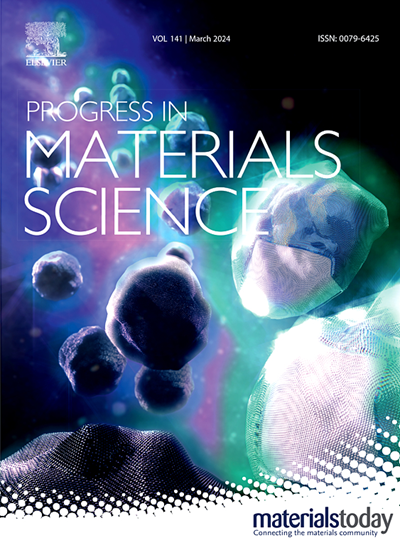基于蛋白质/肽的刺激响应型水凝胶及其传感应用
IF 33.6
1区 材料科学
Q1 MATERIALS SCIENCE, MULTIDISCIPLINARY
引用次数: 0
摘要
刺激响应水凝胶是一种含有大量水分的智能三维材料,可对不同的刺激做出反应。典型的聚合物水凝胶可以低成本设计,用于各种刺激。然而,由于缺乏特异性,高分子水凝胶感知特定生物刺激或生物分子的能力较弱,这就导致了使用蛋白质、肽、适配体等的新兴水凝胶的出现。本文概述了快速发展的基于蛋白质/肽的刺激响应水凝胶领域的最新进展。特别强调了由不同构件(即螺旋自组装、β-片和 β-发夹自组装、包含活性域的蛋白质/肽、蛋白质/肽单体)制成的蛋白质/肽基水凝胶及其独特的结构和性质。然后回顾了基于刺激响应蛋白质/肽的水凝胶在物理、化学和生物传感器应用中的最新发展。最后,我们讨论了生物分子水凝胶及其潜在应用所面临的挑战,并展望了其未来的发展前景。本文章由计算机程序翻译,如有差异,请以英文原文为准。
Stimuli-responsive hydrogels based on protein/peptide and their sensing applications
Stimuli-responsive hydrogels are smart three-dimensional materials containing a huge amount of water, which can respond to different stimuli. Typical polymeric hydrogels can be designed for a range of stimuli at low cost. However, polymeric hydrogels are less capable of sensing specific biological stimuli or biomolecules owing to the lack of specificity, which led to emerging hydrogels using proteins, peptides, aptamers and so on. In this paper, we outline the recent progress made in the fast-growing field of protein/peptide-based stimuli-responsive hydrogels. Specially, an emphasis is given to the protein/peptide-based hydrogels fabricated by different building blocks, namely, helix self-assemblies, β-sheet and β-hairpin self-assemblies, protein/peptide incorporating active domains, protein/peptide monomers, and their unique structures and properties. The latest development of stimuli-responsive protein/peptide-based hydrogels in physical, chemical and biological sensor applications are then reviewed. Finally, we discuss the challenges and envision future development of biomacromolecular hydrogels and their potential applications.
求助全文
通过发布文献求助,成功后即可免费获取论文全文。
去求助
来源期刊

Progress in Materials Science
工程技术-材料科学:综合
CiteScore
59.60
自引率
0.80%
发文量
101
审稿时长
11.4 months
期刊介绍:
Progress in Materials Science is a journal that publishes authoritative and critical reviews of recent advances in the science of materials. The focus of the journal is on the fundamental aspects of materials science, particularly those concerning microstructure and nanostructure and their relationship to properties. Emphasis is also placed on the thermodynamics, kinetics, mechanisms, and modeling of processes within materials, as well as the understanding of material properties in engineering and other applications.
The journal welcomes reviews from authors who are active leaders in the field of materials science and have a strong scientific track record. Materials of interest include metallic, ceramic, polymeric, biological, medical, and composite materials in all forms.
Manuscripts submitted to Progress in Materials Science are generally longer than those found in other research journals. While the focus is on invited reviews, interested authors may submit a proposal for consideration. Non-invited manuscripts are required to be preceded by the submission of a proposal. Authors publishing in Progress in Materials Science have the option to publish their research via subscription or open access. Open access publication requires the author or research funder to meet a publication fee (APC).
Abstracting and indexing services for Progress in Materials Science include Current Contents, Science Citation Index Expanded, Materials Science Citation Index, Chemical Abstracts, Engineering Index, INSPEC, and Scopus.
 求助内容:
求助内容: 应助结果提醒方式:
应助结果提醒方式:


